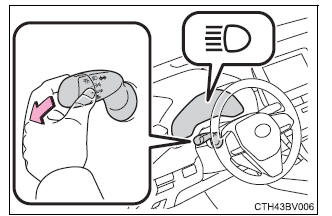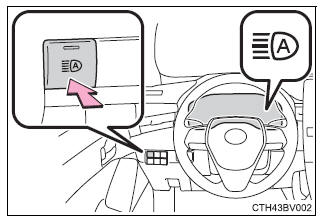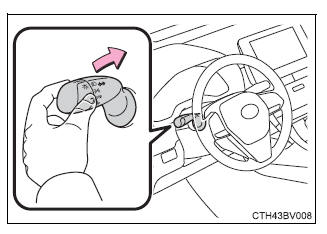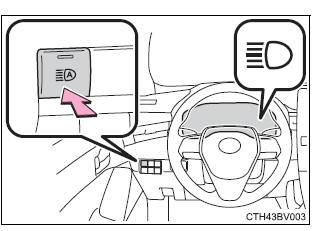The Automatic High Beam uses a camera sensor located behind
the upper portion of the windshield to assess the brightness of
the lights of vehicles ahead, streetlights, etc., and
automatically
turns the high beams on or off as necessary.
| WARNING ■Limitations of the Automatic High
Beam
Do not overly rely on the Automatic High Beam. Always drive
safely, taking
care to observe your surroundings and turning the high beams
on or off
manually if necessary.
■To prevent incorrect operation of the Automatic High Beam
system
Do not overload the vehicle. |
Activating the Automatic High Beam
1. Push the lever away from you
with the headlight switch in the  or
or  position. position.

2. Press the Automatic High
Beam switch.
The Automatic High Beam indicator
will come on when the system
is operating.

Turning the high beams on/off manually
■ Switching to the low beams
Pull the lever to its original position.
The Automatic High Beam indicator
will turn off.
Push the lever away from you to
activate the Automatic High
Beam system again.

■ Switching to the high beams
Press the Automatic High
Beam switch.
The Automatic High Beam indicator
will turn off and the high
beam indicator will turn on.
Press the switch to activate the
Automatic High Beam system
again.

■Conditions to turn the high beams on/off automatically
- When all of the following conditions are met, the high beams
will be turned
on automatically (after approximately 1 second):
- The vehicle speed is approximately 21 mph (34 km/h) or
more.
- The area ahead of the vehicle is dark.
- There are no vehicles ahead with headlights or tail
lights turned on.
- There are few streetlights on the road ahead.
- If any of the following conditions is met, the high beams
will turn off automatically:
- The vehicle speed is below approximately 17 mph (27
km/h).
- The area ahead of the vehicle is not dark.
- Vehicles ahead have their headlights or tail lights
turned on.
- There are many streetlights on the road ahead.
■Camera sensor detection information
- The high beams may not be automatically turned off in the
following situations:
- When a vehicle suddenly appears from around a curve
- When the vehicle is cut in front of by another vehicle
- When vehicles ahead cannot be detected due to repeated
curves, road
dividers or roadside trees
- When vehicles ahead appear in a faraway lane on a wide
road
- When the lights of vehicles ahead are not on
- The high beams may be turned off if a vehicle ahead that is
using fog lights
without its headlights turned on is detected.
- House lights, street lights, traffic signals, and
illuminated billboards or signs
and other reflective objects may cause the high beams to change
to the low
beams, or the low beams to remain on.
- The following factors may affect the amount of time taken
for the high
beams to turn on or off:
- The brightness of the headlights, fog lights, and tail
lights of vehicles
ahead
- The movement and direction of vehicles ahead
- When a vehicle ahead only has operational lights on one
side
- When a vehicle ahead is a two-wheeled vehicle
- The condition of the road (gradient, curve, condition of
the road surface,
etc.)
- The number of passengers and amount of luggage in the
vehicle
- The high beams may turn on or off unexpectedly.
- Bicycles or similar vehicles may not be detected.
- In the following situations the system may not be able to
correctly detect the
surrounding brightness level. This may cause the low beams to
remain on
or the high beams to flash or dazzle pedestrians or vehicles
ahead. In such
a case, it is necessary to manually switch between the high and
low beams.
- When driving in inclement weather (heavy rain, snow,
fog, sandstorms,
etc.)
- When the windshield is obscured by fog, mist, ice, dirt,
etc.
- When the windshield is cracked or damaged
- When the camera sensor is deformed or dirty
- When the temperature of the camera sensor is extremely
high
- When the surrounding brightness level is equal to that
of headlights, tail
lights or fog lights
- When headlights or tail lights of vehicles ahead are
turned off, dirty,
changing color, or not aimed properly
- When the vehicle is hit by water, snow, dust, etc. from
a preceding vehicle
- When driving through an area of intermittently changing
brightness and
darkness
- When frequently and repeatedly driving
ascending/descending roads, or
roads with rough, bumpy or uneven surfaces (such as
stone-paved
roads, gravel roads, etc.)
- When frequently and repeatedly taking curves or driving
on a winding
road
- When there is a highly reflective object ahead of the
vehicle, such as a
sign or mirror
- When the back of a preceding vehicle is highly
reflective, such as a container
on a truck
- When the vehicle's headlights are damaged or dirty, or
are not aimed
properly
- When the vehicle is listing or titling due to a flat
tire, a trailer being towed,
etc.
- When the headlights are changed between the high beams
and low
beams repeatedly in an abnormal manner
- When the driver believes that the high beams may be
flashing or dazzling
pedestrians or other drivers
■Temporarily lowering sensor sensitivity
The sensitivity of the sensor can be temporarily lowered.
1. Turn the engine switch off while the following conditions are
met.
- The headlight switch is in
 . .
- The headlight switch lever is in high beam position.
2. Turn the engine switch to the IGNITION ON mode.
3. Within 5 seconds after 2, repeat pulling the headlight switch
lever to the
original position then pushing it to the high beam position quickly
9 times,
then leave the lever in high beam position.
Automatic High Beam (headlights) may turn on even when the vehicle
is
stopped. |